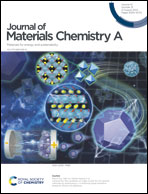3D-printed flexible supercapacitors with multi-level bonded configuration via ion cross-linking†
Abstract
Recent fast development of the Internet of Things has increased the demand for wearable and bio-integrated flexible electronic systems. However, stretchable and flexible energy storage devices are still challenging since their neighboring electrodes are highly susceptible to relative detachment during complex external deformation, leading to the destruction of the whole device. Herein, we report a versatile strategy of multi-level bridged configurations for flexible and stretchable energy storage devices. An in situ introduced crosslinking of alginate chains results in multi-level tight connections in both inner parts and interface of the electrode and the electrolyte, which simultaneously improve mechanical properties and interfacial connections thus resulting in high interface charge transfer efficiency and ultra-stable electrochemical performance under various deformation states. As demonstrated by an all 3D-printed integrated MXene-based stretchable supercapacitor, the crosslinked cell achieves an areal capacitance of 2.7 F cm−2 at 7 mA cm−2, which is much better than the device without such bridging. In addition, the crosslinked device also exhibits much improved mechanical flexibility that works well under 50% strain for 2000 repeated stretch/release cycles. The multi-level bridged strategy can be extended to the simultaneous improvement of the mechanical and electrochemical properties of other materials, which paves a good way for next-generation high performance super-stretchable electronics.



 Please wait while we load your content...
Please wait while we load your content...